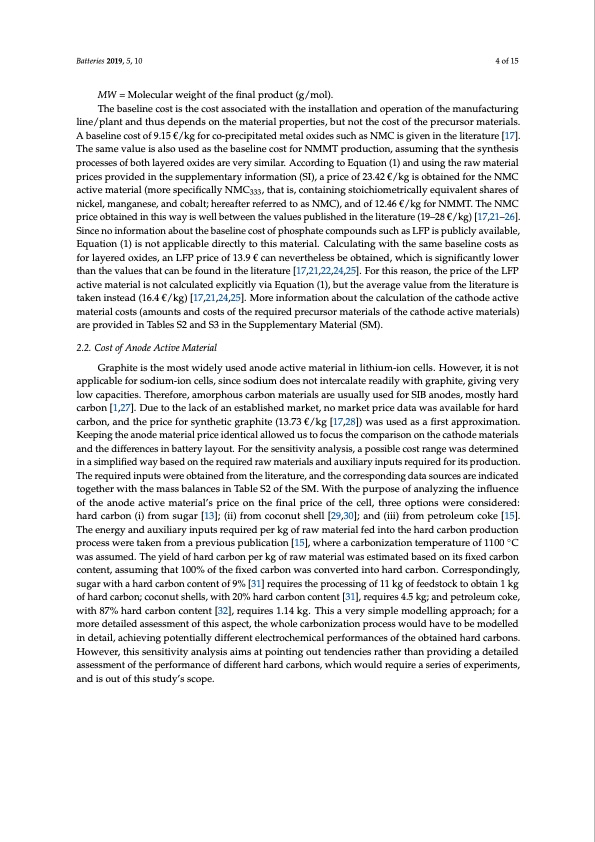
PDF Publication Title:
Text from PDF Page: 004
Batteries 2019, 5, 10 4 of 15 MW = Molecular weight of the final product (g/mol). The baseline cost is the cost associated with the installation and operation of the manufacturing line/plant and thus depends on the material properties, but not the cost of the precursor materials. A baseline cost of 9.15 €/kg for co-precipitated metal oxides such as NMC is given in the literature [17]. The same value is also used as the baseline cost for NMMT production, assuming that the synthesis processes of both layered oxides are very similar. According to Equation (1) and using the raw material prices provided in the supplementary information (SI), a price of 23.42 €/kg is obtained for the NMC active material (more specifically NMC333, that is, containing stoichiometrically equivalent shares of nickel, manganese, and cobalt; hereafter referred to as NMC), and of 12.46 €/kg for NMMT. The NMC price obtained in this way is well between the values published in the literature (19–28 €/kg) [17,21–26]. Since no information about the baseline cost of phosphate compounds such as LFP is publicly available, Equation (1) is not applicable directly to this material. Calculating with the same baseline costs as for layered oxides, an LFP price of 13.9 € can nevertheless be obtained, which is significantly lower than the values that can be found in the literature [17,21,22,24,25]. For this reason, the price of the LFP active material is not calculated explicitly via Equation (1), but the average value from the literature is taken instead (16.4 €/kg) [17,21,24,25]. More information about the calculation of the cathode active material costs (amounts and costs of the required precursor materials of the cathode active materials) are provided in Tables S2 and S3 in the Supplementary Material (SM). 2.2. Cost of Anode Active Material Graphite is the most widely used anode active material in lithium-ion cells. However, it is not applicable for sodium-ion cells, since sodium does not intercalate readily with graphite, giving very low capacities. Therefore, amorphous carbon materials are usually used for SIB anodes, mostly hard carbon [1,27]. Due to the lack of an established market, no market price data was available for hard carbon, and the price for synthetic graphite (13.73 €/kg [17,28]) was used as a first approximation. Keeping the anode material price identical allowed us to focus the comparison on the cathode materials and the differences in battery layout. For the sensitivity analysis, a possible cost range was determined in a simplified way based on the required raw materials and auxiliary inputs required for its production. The required inputs were obtained from the literature, and the corresponding data sources are indicated together with the mass balances in Table S2 of the SM. With the purpose of analyzing the influence of the anode active material’s price on the final price of the cell, three options were considered: hard carbon (i) from sugar [13]; (ii) from coconut shell [29,30]; and (iii) from petroleum coke [15]. The energy and auxiliary inputs required per kg of raw material fed into the hard carbon production process were taken from a previous publication [15], where a carbonization temperature of 1100 ◦C was assumed. The yield of hard carbon per kg of raw material was estimated based on its fixed carbon content, assuming that 100% of the fixed carbon was converted into hard carbon. Correspondingly, sugar with a hard carbon content of 9% [31] requires the processing of 11 kg of feedstock to obtain 1 kg of hard carbon; coconut shells, with 20% hard carbon content [31], requires 4.5 kg; and petroleum coke, with 87% hard carbon content [32], requires 1.14 kg. This a very simple modelling approach; for a more detailed assessment of this aspect, the whole carbonization process would have to be modelled in detail, achieving potentially different electrochemical performances of the obtained hard carbons. However, this sensitivity analysis aims at pointing out tendencies rather than providing a detailed assessment of the performance of different hard carbons, which would require a series of experiments, and is out of this study’s scope.PDF Image | Exploring the Economic Potential of Sodium-Ion Batteries

PDF Search Title:
Exploring the Economic Potential of Sodium-Ion BatteriesOriginal File Name Searched:
Exploring_the_Economic_Potential_of_Sodium-Ion_Bat.pdfDIY PDF Search: Google It | Yahoo | Bing
Salgenx Redox Flow Battery Technology: Salt water flow battery technology with low cost and great energy density that can be used for power storage and thermal storage. Let us de-risk your production using our license. Our aqueous flow battery is less cost than Tesla Megapack and available faster. Redox flow battery. No membrane needed like with Vanadium, or Bromine. Salgenx flow battery
| CONTACT TEL: 608-238-6001 Email: greg@salgenx.com | RSS | AMP |